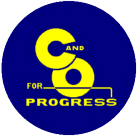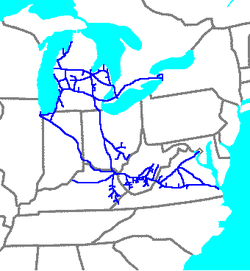
Back Chesapeake and Ohio Railway German Chesapeake and Ohio Railway French チェサピーク・アンド・オハイオ鉄道 Japanese 切薩皮克與俄亥俄鐵路 Chinese
 | |
 The C&O system map in 1950 | |
| Overview | |
|---|---|
| Headquarters | Cleveland, Ohio |
| Reporting mark | C&O, CO |
| Locale | District of Columbia, Illinois, Indiana, Kentucky, Michigan, New York, Ohio, Ontario, Pennsylvania, Virginia, West Virginia and Wisconsin |
| Dates of operation | 1868–1987 |
| Predecessor | Louisa Railroad |
| Successor | CSX |
| Technical | |
| Track gauge | 4 ft 8+1⁄2 in (1,435 mm) standard gauge |
The Chesapeake and Ohio Railway (reporting marks C&O, CO) was a Class I railroad formed in 1869 in Virginia from several smaller Virginia railroads begun in the 19th century. Led by industrialist Collis P. Huntington, it reached from Virginia's capital city of Richmond to the Ohio River by 1873, where the railroad town (and later city) of Huntington, West Virginia, was named for him.
The C&O traces its origins to the Louisa Railroad of Louisa County, Virginia, begun in 1836. By 1850 the Louisa had been built east to Richmond and west to Charlottesville, and in keeping with its new and larger vision, was renamed the Virginia Central Railroad. The Commonwealth of Virginia owned a portion of Virginia Central stock and financed the Blue Ridge Railroad to accomplish the task of crossing the first mountain barrier to the west.
During the Civil War the Virginia Central played a key role in several battles but was a target for Federal armies. By 1865 it only had five miles of track still in operation and almost no cash to rebuild. Officials realized that they would have to get capital to rebuild from outside the economically devastated South and succeeded in getting Collis Huntington interested. He supplied the Virginians with the money needed to complete the line through what is now West Virginia. The old Covington and Ohio Railroad properties were conveyed to the C&O in keeping with its new mission of linking the Atlantic Ocean with the “Western Waters” of the Ohio River.[1]
Huntington intended to connect the C&O with his Western and Midwestern holdings, but ended up stopping construction at the Ohio River. Thus the only connection to the West was by packet boats operating on the river. Because the mineral resources of West Virginia and Kentucky hadn’t been fully realized yet, the C&O suffered through the bad times brought on by the financial panic Depression of 1873, and went into receivership in 1878. When reorganized it was renamed The Chesapeake and Ohio Railway Company.
Conditions improved in the 1880s when coal resources began to be developed and shipped eastward. In 1881 the Peninsula Extension was completed from Richmond to the new city of Newport News located on Hampton Roads, the East’s largest ice-free port. Transportation of coal to Newport News where it was loaded on coastwise shipping and transported to the Northeast became a staple of the C&O’s business at this time. In 1888 the C&O built the Cincinnati Division from Huntington down the South bank of the Ohio River and across the river at Cincinnati, connecting with the “Big Four” and other Midwestern Railroads. From 1900 to 1920 most of the C&O’s line tapping the rich bituminous coal fields of West Virginia and Kentucky were completed, and the C&O as it was known throughout the rest of the 20th Century was essentially in place. In 1910, the C&O absorbed the Chicago, Cincinnati and Louisville Railroad, which had been built diagonally across the state of Indiana from Cincinnati to Hammond in the preceding decade. This gave the C&O a direct line from Cincinnati to the great railroad hub of Chicago.[2]
The first small terminal and repair shops were located at Richmond beginning in 1860. After expanding to Huntington in 1872, the primary back shops were established on 100 acres of land along Fifth Avenue. These facilities were expanded and modernized over a five year period in three phases beginning in 1916. Another large shop site was established at Clifton Forge, Virginia in 1890 on 1,200 acres of land, including the classification yard. In 1929 the system's primary freight car repair and erecting facility was built at the west end of the mammoth yard at Russell, Kentucky, called the Raceland Car Shops.[3]
By the early 1960s the C&O was headquartered in Cleveland, Ohio. In 1972, under the leadership of Cyrus Eaton, it became part of the Chessie System, along with the Baltimore and Ohio and Western Maryland Railway. The Chessie System was later combined with the Seaboard Coast Line and Louisville and Nashville, both the primary components of the Family Lines System, to become a key portion of CSX Transportation (CSXT) in the 1980s.[4]
C&O's passenger services ended in 1971 with the formation of Amtrak. Today Amtrak's tri-weekly Cardinal passenger train follows the historic and scenic route of the C&O through the New River Gorge in one of the more rugged sections of West Virginia. The rails of the former C&O also continue to transport intermodal and freight traffic, as well as West Virginia bituminous coal east to Hampton Roads and west to the Great Lakes as part of CSXT, a Fortune 500 company which was one of seven Class I railroads operating in North America at the beginning of the 21st century.
At the end of 1970 C&O operated 5,067 mi (8,155 km) of road on 10,219 mi (16,446 km) of track, not including WM or B&O and its subsidiaries.
- ^ Chesapeake and Ohio Historical Society
- ^ Chesapeake and Ohio Historical Society
- ^ The Back Shop Illustrated, Volume III: Southeast and Western Regions.
- ^ Surface Transportation Board, Docket AB_55_627_X Archived 2007-03-21 at the Wayback Machine, CSX Transportation, Inc.--abandonment exemption—in Floyd County, KY, February 14, 2003
© MMXXIII Rich X Search. We shall prevail. All rights reserved. Rich X Search